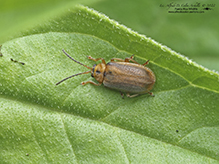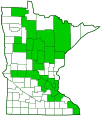black-margined loosestrife beetle
(Neogalerucella calmariensis)
Conservation • Description • Habitat • Ecology • Distribution • Taxonomy
|
|
||||||||||||||
Description |
Black-margined loosestrife beetle is an exotic, small leaf beetle. It is native to Europe, Asia, northwest Africa, and Australia. It was intentionally released, along with the closely related golden loosestrife beetle (Neogalerucella pusilla), into 27 states in the United States and 6 provinces in Canada to control the spread of invasive purple loosestrife. In the U.S., it now occurs from Maine to Maryland, west to Minnesota and Illinois, and in Washington and northern Oregon. It is now common and widespread in Minnesota. Black-margined loosestrife beetle is a food specialist. In North America, it feeds only on purple loosestrife. Prior to its introduction, fifty other plant species were tested in Europe for susceptibility to this beetle. Only winged loosestrife was found susceptible, but it is not attacked when purple loosestrife is available. Adults are ⅛″ to ¼″ (3.6 to 5.6 mm) long and about half that wide. The body is elongate, parallel sided, coarsely pitted (punctate), and densely covered with short fine hairs. It is light brownish-yellow, brownish orange, or brownish red (pale) with dark brown to black (dark) markings. The head is inserted into the first segment of the thorax and is visible from above. It is mostly pale, but the top of the head (vertex) is dark. The antennae have 11 segments and are less than half as long as the body. The third antennal segment is longer than the fourth. The antennae bases are close together. The eyes are not notched. The mouthparts are directed downwards. The plate covering the first segment of the thorax (pronotum) is two times wider than it is long. It is pale with a dark triangle or longitudinal stripe in the middle. The plate between the wing bases (scutellum) is black. The hardened wing covers (elytra) are rounded in the shoulder (humeral) area, nearly parallel along the sides, and broadly rounded at the tip. Each elytron has a single broad, dark, ill-defined, longitudinal stripe. The stripe extends from the base to about two-thirds of the way to the tip. The legs are mostly pale. The third segment (femur) on each leg is mostly dark. The last part of each leg (tarsus), corresponding to the foot, has five segments. The fourth segment is very short and is concealed within the broadened tip of the third segment, making the tarsus appear to have only four segments. |
Size |
Total length: ⅛″ to ¼″ (3.6 to 5.6 mm) |
Similar Species |
Golden loosestrife beetle (Neogalerucella pusilla) is usually mostly pale, with a large dark spot on the vertex, and often a small dark spot each elytron at the shoulder (humeral) angle. |
Habitat |
Wherever its host occurs |
Ecology |
Season |
One generation per year: April to August |
Behavior |
|
Life Cycle |
Adults overwinter in leaf litter near a host plant. They emerge the following year in early spring. The female lays 2 to 10 eggs on the stem or in a leaf axil of a host plant. She can lay 300 to 400 eggs in her lifetime. Mature larvae drop to the ground and pupate in leaf litter below the host plant. |
Larva Food |
Purple loosestrife |
Adult Food |
Purple loosestrife |
Damage |
The first stage (instar) larvae feed within leaf buds and flower buds. Later instars feed exposed on buds, leaves, and stem tissue. They feed on the photosynthetic tissue of the leaves, leaving the upper epidermis intact. This creates a distinctive “windowpane” effect. A heavy infestation can completely defoliate a plant. A lighter infestation will leave some leaf tissue, but it will cause reduced vigor, and the plant will not produce seeds. Adults chew holes in young leaves, causing a characteristic “shothole” effect. |
Distribution |
||
|
Sources |
|
| 8/8/2024 | ||
Occurrence |
||
Common |
||
Taxonomy |
|
Order |
Coleoptera (Beetles) |
Suborder |
Polyphaga (Water, Rove, Scarab, Long-horned, Leaf, and Snout Beetles) |
Infraorder |
Cucujiformia |
Superfamily |
Chrysomeloidea (leaf beetles and allies) |
Family |
Chrysomelidae (leaf beetles) |
Subfamily |
Galerucinae (skeletonizing leaf and flea beetles) |
Tribe |
Galerucini |
Section |
Atysites |
Genus |
Neogalerucella (purple loosestrife beetles) |
Subgenus |
Neogalerucella (cella beetles) |
This species was originally described as Chrysomela calmariensis by Carl Linnaeus in 1767. In 1833, it was placed in the genus Galerucella by Jean-Baptiste Boisduval. In 1962, Makoto Chûjô proposed a new genus, Neogalerucella, for several species including calmariensis, but the placement was not widely recognized. The Catalog of the Leaf Beetles of America North of Mexico, published by The Coleopterists Society in 2003, recognized Neogalerucella calmariensis. The Catalog of Palearctic Coleoptera, edited by I. Löbl and A. Smetana and published by Apollo Books in 2010, demoted Neogalerucella to a subgenus of Galerucella, and once again recognized this species as Galerucella calmariensis. Currently, most taxonomic sources classify this species as Neogalerucella calmariensis. These include ITIS, GBIF, NatureServe, and BugGuide.net. Many sources still prefer the older classification Galerucella calmariensis due to historical precedent and morphological similarities. These include iNaturalist, EDDMaps, and Invasive.org. Some sources, including NCBI and Discover Life, avoid the controversy by listing both species names as valid. |
|
Subordinate Taxa |
|
|
|
Synonyms |
|
Chrysomela calmariensis Chrysomela griseaalni Galeruca aquatica Galeruca calmariensis Galleruca lythri Galleruca pallida Galerucella calmariensis Galerucella calmariensis nigripes Galerucella lineatipes |
|
Common Names |
|
black-margined loosestrife beetle |
|
Glossary
Elytra
The hardened or leathery forewings of beetles used to protect the fragile hindwings, which are used for flying. Singular: elytron.
Femur
On insects and arachnids, the third, largest, most robust segment of the leg, coming immediately before the tibia. On humans, the thigh bone.
Pronotum
The exoskeletal plate on the upper side of the first segment of the thorax of an insect.
Punctate
Dotted with pits (punctures), translucent sunken glands, or colored spots of pigment.
Scutellum
The exoskeletal plate covering the rearward (posterior) part of the middle segment of the thorax in some insects. In Coleoptera, Hemiptera, and Homoptera, the dorsal, often triangular plate behind the pronotum and between the bases of the front wings. In Diptera, the exoskeletal plate between the abdomen and the thorax.
Tarsus
On insects, the last two to five subdivisions of the leg, attached to the tibia; the foot. On spiders, the last segment of the leg. Plural: tarsi.
vertex
The upper surface of an insect’s head.
visitor Photos |
||
Share your photo of this insect. |
||
This button not working for you? |
||
Alfredo Colon |
||
 |
 |
|
 |
||
MinnesotaSeasons.com Photos |
||
|
||
|
||

Slideshows |
|

visitor videos |
||
Share your video of this insect. |
||
This button not working for you? |
||
|
Other videos |
||
Galerucella Beetle Project |
About
Jun 19, 2013 According to Galarucella beetles, Purple Loosestrife is delicious. Metro vancouver Parks is studying the potential of these beetles as a biological control against purple loosestrife – an invasive that can destroy our wetlands. |
Galerucella beetle harvest |
About
Jun 5, 2013 Adirondack Park Invasive Plant Program (APIPP) Summer Educator, Billy Martin, collects Galerucella beetles under the supervision of Terrestrial Invasive Species Project Coordinator, Brendan Quirion, near Elizabethtown, NY. They will rear the Galerucella beetles off-site using sample Purple Loosestrife plants giving APIPP another option for managing Purple Loosestrife infestations. For more information visit our blog at www.adk-invasives.blogspot.com. |
Galerucella beetle larvae Cambridge Ontario 2013 |
About
Jun 24, 2013 Galerucella calmariensis and G. pusilla are leaf feeding beetles that are natural predators and classical biocontrol agents of the herbaceous non-native plant purple loosestrife (Lythrum salicaria). See the beetle larvae and their feeding damage in this short video. |
Environmental Laboratory - U.S. Army Corps of Engineers |
About
Feb 15, 2013 video of Galerucella calmariensis feeding on purple loosestrife. |

visitor Sightings |
||
Report a sighting of this insect. |
||
This button not working for you? |
||
| Alfredo Colon 7/7/2024 |
Location: Albany, NY |
 |
| Alfredo Colon 7/6/2024 |
Location: Albany, NY |
 |
| Alfredo Colon 6/12/2024 |
Location: Albany, NY |
 |
| Alfredo Colon 8/2/2022 |
Location: Albany, NY |
 |
MinnesotaSeasons.com Sightings |
||
|

Created: 1/27/2024 Last Updated: © MinnesotaSeasons.com. All rights reserved. |

